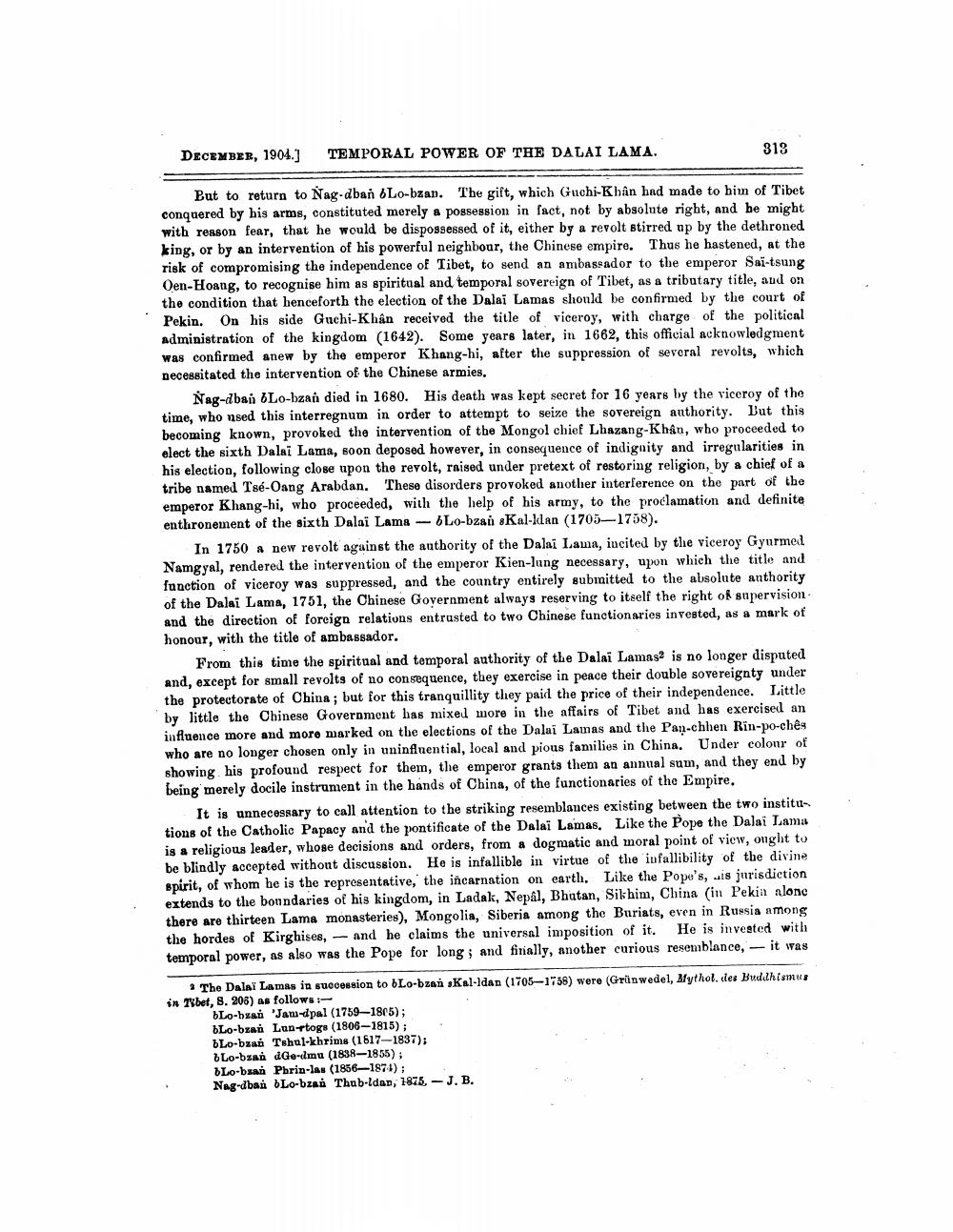________________
DECEMBER, 1904.1
TEMPORAL POWER OF THE DALAI LAMA.
313
But to return to Nag-dban 6 Lo-bzan. The gift, which Guchi-Khân had made to him of Tibet conquered by his arms, constituted merely a possession in fact, not by absolute right, and be might with reason fear, that he would be dispossessed of it, either by a revolt stirred up by the dethroned king, or by an intervention of his powerful neighbour, the Chinese empire. Thus he hastened, at the risk of compromising the independence of Tibet, to send an ambassador to the emperor Saï-tsung Oen-Hoang, to recognise him as spiritual and temporal sovereign of Tibet, as a tributary title, and on the condition that henceforth the election of the Dalai Lamas should be confirmed by the court of Pekin. On his side Guchi-Khân received the title of viceroy, with charge of the political administration of the kingdom (1642). Some years later, in 1662, this official acknowledgment was confirmed anew by the emperor Khang-hi, after the suppression of several revolts, which necessitated the intervention of the Chinese armies.
Nag-dba 6Lo-bzan died in 1680. His death was kept secret for 16 years by the viceroy of the time, who nsed this interregnum in order to attempt to seize the sovereign authority. But this becoming known, provoked the intervention of the Mongol chief Lhazang-Khan, who proceeded to elect the sixth Dalai Lama, soon deposed however, in consequence of indignity and irregularities in his election, following close upon the revolt, raised under pretext of restoring religion, by a chief of a tribe named Tsé-Oang Arabdan. These disorders provoked another interference on the part of the emperor Khang-hi, who proceeded, with the help of his army, to the proclamation and definite enthronement of the sixth Dalai Lama - Lo-bzan Kal-ldan (1705-1758).
In 1750 a new revolt against the authority of the Dalai Lama, incited by the viceroy Gyurmed Namgyal, rendered the intervention of the emperor Kien-lung necessary, upon which the title and function of viceroy was suppressed, and the country entirely submitted to the absolute anthority of the Dalai Lama, 1751, the Chinese Government always reserving to itself the right of supervision and the direction of foreign relations entrusted to two Chinese functionaries invested, as a mark of honour, with the title of ambassador.
From this time the spiritual and temporal authority of the Dalai Lamas? is no longer disputed and, except for small revolts of no consequence, they exercise in peace their double sovereignty under the protectorate of China ; but for this tranquillity they paid the price of their independence. Little by little the Chinese Government has mixed more in the affairs of Tibet and has exercised an influence more and more marked on the elections of the Dalai Lamas and the Pan-chhen Rin-po-chês who are no longer chosen only in uninfluential, local and pious families in China. Under colour of showing his profound respect for them, the emperor grants them an annual sum, and they end by being merely docile instrument in the hands of China, of the functionaries of the Empire,
It is unnecessary to call attention to the striking resemblances existing between the two institutions of the Catholic Papacy and the pontificate of the Dalai Lamas. Like the Pope the Dalai Lama is a religious leader, whose decisions and orders, from a dogmatic and moral point of view, onght to be blindly accepted without discussion. He is infallible in virtue of the infallibility of the divine spirit, of whom he is the representative, the incarnation on earth. Like the Pope's, wis jurisdiction extends to the boundaries of his kingdom, in Ladak, Nepal, Bhutan, Sikhim, China (in Pekin alone there are thirteen Lama monasteries), Mongolia, Siberin among the Buriats, even in Russia among the hordes of Kirghises, and he claims the universal imposition of it. He is invested with temporal power, as also was the Pope for long; and finally, another curious resemblance, - it was
The Dalai Lamas in succession to bLo-bzan Kal-ldan (1705-1758) were (Grinwedel, Mythol. dles Buddhismus in Tibet, 8. 206) as follows:
bLo-buan 'Jam-dpal (1759-1805); bLo-bzań Lunstogs (1806-1815); bLo-bzan Tshul-khrims (1617-1837); Lo-brande-ilmu (1838-1855); Lo-buan Pbrin-las (1856-1874); Nag-dbań Lo-bzhi Thub-ldan, 1875,- J.B.




